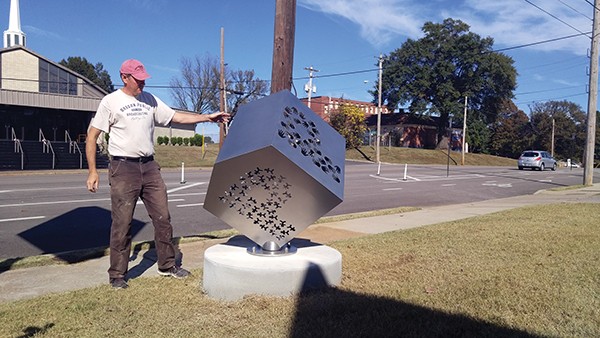From its history in the civil rights movement to the controversial “P,” Binghampton’s cultural heritage is being honored in three new sculptures.
The Historic Broad Avenue Arts Alliance, the UrbanArt Commission, and the Binghampton Development Corporation partnered to install three sculptures focusing on the history of the neighborhood. Pete Beeman, a public artist who splits his time between Oregon and New York, created the artwork.
The interactive sculptures were installed last week at the Water Tower Pavilion and Christ Community Health Services, both on Broad, and the Lester Community Center on Tillman.
“So much public art is too many steps removed from the community it’s attached to,” Beeman said. “This one is great because it really is attached to the community. It really is supposed to be about the community.”
Beeman said he enjoys doing large-scale public art, but he says these sculptures are more “human-scale.” People who live in the neighborhood or pass through on the Hampline bike path can actually interact with each one in their own way.
Each of the three sculptures highlights a facet of Binghampton history.
One of the sculptures pays homage to the founding of the neighborhood, which used to be its own town, and William H. Bingham, the town’s first mayor. When it was incorporated, a clerical error added a “P” to the spelling of the town until the Tennessee legislature voted to drop the letter. Regardless, the community and businesses throughout Binghampton have popularized the “P.” On the sculpture in front of Christ Community Health Services, many shapes are cut into the letter “P” onto a four-sided house that twirls when pushed.
 Alexandra Pusateri
Alexandra Pusateri
Artist Pete Beeman and his “P” sculpture
“I don’t know if I’m supposed to be, but I’m 100-percent pro-P,” Beeman said.
The second sculpture focuses on the transportation and railroad history in Binghampton — the manufacturing of boxcars in the area, the railroads that cross Broad, and the residents who were displaced during the halted Interstate 40 project that would split Overton Park. The bicycle lanes that began in 2014 also receive a nod from the sculpture, which is placed in a way that people can watch cyclists on the Hampline in front of the Water Tower Pavilion. The sculpture is a cart, also serving as a bench, along a 12-foot track meant to represent rail. The cart operates with a crank.
The third sculpture, in front of the Lester Community Center, is meant to represent the Binghampton Civic League, which worked for civil rights in Memphis, particularly regarding integration in public institutions like the Memphis Zoo, the Mid-South Fairgrounds, and the Brooks Museum of Art. The sculpture is a set of wings that are 12 feet tall on a base that visitors can stand on, making it appear that they have the symbolic wings.
“The attitude around here is great,” Beeman said. “It’s clear that the attitude is connected to the neighborhood, and they’re all psyched about their neighborhood. They’re invested in it. You don’t get that everywhere.”